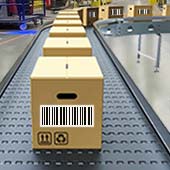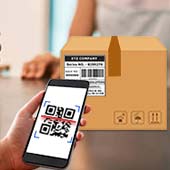
Implement Barcode in Postal Service and Explaining its Barcode Type
Barcode is printed on the shipping label for identify a shipment and tracking. It is scanned at each phase of the delivery until it reaches the customer’s shipping destination.
Barcodes hold information about parcels that carriers use to complete shipping. When you scan the barcode on a shipping label, you can quickly see information about the order and access information such as tracking number, mode of shipping, customer name and delivery address.
How use Barcode in Postal Service

While Receiving the Inventory in the Fulfillment Center:
Barcode is printed on the shipping label for identify a shipment and tracking. It is scanned at each phase of the delivery until it reaches the customer’s shipping destination.
Barcodes hold information about parcels that carriers use to complete shipping. When you scan the barcode on a shipping label, you can quickly see information about the order and access information such as tracking number, mode of shipping, customer name and delivery address.

For Handing Offers for the End Consumer to Shipping Carriers:
The retailers or e-commerce companies hand out shipments to the courier companies, and right before this, the carrier will scan the barcode before the package leaves the fulfillment center.
It is important to keep a record of how many parcel shipments are being handed out on a daily basis.

While Receiving Returns from End Consumers:
These kinds of returns are an inevitable part of e-commerce, but for those who have customers ship their returned products back to the third-party logistics provider, the shipping barcode is thoroughly scanned before they accept the return order.
Types of Barcode labels in Postal Services
Shipping Barcodes (on shipping labels or receiving slips):
The Fulfillment centre scans the shipping barcode labels when receiving and shipping courier. Shipping barcodes help in tracking out-of-stock situations as well as delivery exceptions.
Product Barcodes (on the products they receive, store, and ship):
Storage location Barcodes are used for each individual bin, shelf, or pallet location. Use of barcodes on the individual unit level can be even more secure and improve accuracy. Barcodes help to ship the right couriers from the right brands to the right customers.
Implement Barcode in Courier Service
Generate Barcode
With "Post office Barcode Generator tool" that helps to create shipping barcodes for their products. Software allows users to select the barcode they need, enter the necessary information like address, tracking number, customer name and then generate the barcode.
Generated barcode can track products or services through the system. You can generate barcodes in various formats: PNG, JPEG, TIFF, BMP, and GIF. We support the following barcode symbologies for postal services, such as Code 93, USPS Sack Label, Planet, and Postnet.
Add Generated Barcodes to Product
Apply your generated barcode to obtain tracking parcel information such as date, time, and location of the most recent event. It also helps to get an estimated delivery date of shipping items and tracking details.
Postal Barcode Types
-
Planet
Planet Barcode Technique is a one-dimensional barcode symbology used to identify and track parcels during their delivery. The United States Postal Service uses a combination of Postnet and Planet tracking codes to track posts.
-
Postnet
Postnet stands for Postal Numeric Encoding Technique. The Postnet barcode starts and ends with a full bar (often called a guard rail or frame bar). POSTNET is not a real barcode since a barcode is coded by bars of variable width, while the barcode POSTNET is coded by bars of variable height.
-
USPS Sack Label
USPS Sack Label is a 1D barcode symbology that is used by the United States Postal Service for the labeling of postal sacks. The USPS Sack Label barcode encodes 8 digits, i.e., a 5-digit Zip Code (the sack destination) and a 3-digit content identifier number (CIN).
-
Code 93
Code 93 is a variable-length and continuous barcode symbology that represents the full ASCII character set. Code 93 is used by the Canadian postal office to encode delivery details. It is an alphanumeric, variable length 1D barcode symbology that provides higher density and more data security enhancement.
Benefits of Barcode in the Shipping Process

Your packaging manually can lead to several errors. Barcode increase data collection speed across receiving orders & packaging orders. In most cases, barcode scanning gives us information that is almost accurate.

Increasing Speed of Order Processing
Orders cannot be accomplished without the use of barcode scanning technology, which reduces the chances of mistakes.

Increased Mobility and Efficiency
Shipping barcode is scanned by a scanner at each phase of the delivery and tracks assets efficiently.Barcodes also increase the efficiency of shipping process and lower costs to customers.